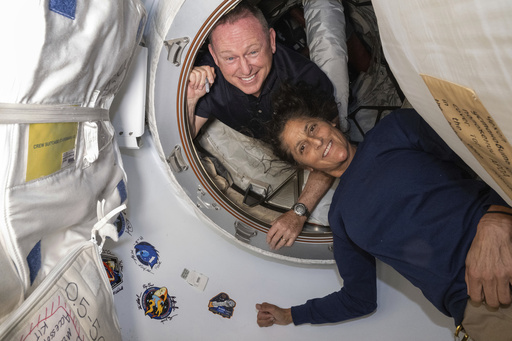NEW YORK (AP) — When two veteran NASA astronauts blasted off on a test drive of Boeing’s new capsule, they expected to head home from the International Space Station in a week or so.
It’s now three weeks and counting for Butch Wilmore and Suni Williams as NASA and Boeing troubleshoot equipment problems that popped up on the way there.
Three potential landing dates were called off and their return flight was put on hold. On Friday, officials said there’s no rush to bring them home and more testing will be done first.
“I want to make it very clear that Butch and Suni are not stranded in space,” said Steve Stich, NASA’s commercial crew program manager.
Stich said the astronauts could use the capsule if there was an emergency at the space station and they needed to make a quick getaway.
The long-delayed test flight is the first with astronauts aboard. Boeing will eventually join SpaceX in ferrying crews to and from the space station for NASA.
Why was the Starliner return trip postponed?
When the return trip was put on hold, NASA said it wanted more time to analyze problems in the spacecraft’s propulsion system, which is used to maneuver in flight. The propulsion system is attached to the capsule, but it doesn’t come back to Earth for inspection. It is ditched during reentry and burns up.
The space agency also said it didn’t want the departure to conflict with spacewalks. But Monday’s spacewalk was called off after water leaked from an astronaut’s spacesuit while she was still inside the orbiting lab. A spacewalk planned for Tuesday has been postponed until the end of July while the leak is scrutinized.
What are the problems being investigated?
Five of the capsule’s 28 thrusters went down during docking, as the capsule closed in on the space station. All but one thruster was restarted, and they worked during a later test firing, NASA said. Officials suspect that heat from all the thruster action at docking caused the shutdown. The one faulty thruster has been turned off.
Stich said more thruster testing on the ground will be done before setting a return date.
The capsule launched June 5 with one small helium leak, but four more leaks sprung up by the time it reached the space station. Helium is used to pressurize fuel for the thrusters, and a faulty rubber seal was suspected in the initial leak. Officials say there’s an ample supply of helium, and Boeing says the leaks are stable and not a concern.
“We understand these issues for safe return,” said Boeing program manager Mark Nappi. “We don’t understand these issues well enough to fix them permanently.”
What’s next?
Stich said it will take a couple weeks for the thruster testing in the New Mexico desert. Initially, officials said the capsule could be at the space station for 45 days because of the batteries on board, but Friday they said that could be extended.
Wilmore and Williams have been pitching in with chores and research at the space station, along with their duties checking out systems on the Boeing capsule. Both previously spent time at the space station. NASA said there were plenty of supplies at the space station for the pair and the seven long-term residents.
___
The Associated Press Health and Science Department receives support from the Howard Hughes Medical Institute’s Science and Educational Media Group. The AP is solely responsible for all content.



